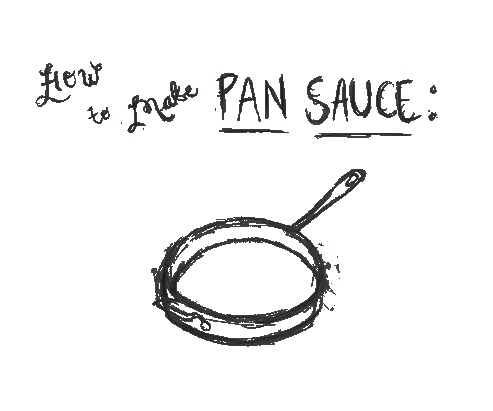What's not to love about a pan sauce? It looks (and tastes) fancy but takes virtually no effort, can be made with pantry staples (especially if wine is considered a pantry staple), and is made in the same vessel you cook with.
If someone told me they were interested in learning to cook but didn't know where to start, I would point them here, to pan sauce land, where a little butter, oniony-type plant, a splash of wine and whatever crusty bits that have developed on the bottom of their saute pan create an extremely flavorful and quick to make sauce that elevates just about anything from proteins to vegetables.

The conceptual process of how to make a pan sauce is this: you'll sear your main event, say chicken or mushrooms, or your favorite vegetarian sausage (mine are Field Roast), then when that item is nice and golden, remove it from the pan and keep it on a plate. Using the juices released + the brown bits that are a result of searing (the technical term for this is fond), you are creating a flavorful base for your pan sauce. You're already halfway there at this stage. Adding just a splash more cooking fat, if necessary (say butter or oil, or a combo of both), you'll add some sort of onion-y type plant, say a shallot or a bit of leek or a good old onion. Once these have begun to brown, you'll throw in something nice and complex and a bit acidic, say lemon juice or wine, which will deglaze (aka lift all that nice caramelization from the bottom of the pan and into your pan sauce). After this, you'll be reducing the sauce twice more. Once after your deglazing agent is added, and again after you add something a bit more plentiful, like stock or even plain old water. Raise the heat until what you've got looks shiny and silky and a little thicker. Turn off the heat and stir in a chunk of butter or heavy cream to add volume and creaminess. You can also add a delicate herb at this stage for a fleck of green. Return your seared protein to the pan and let it all hang for a second. That's it!
To make a pan sauce, you'll need:
- A searable protein or vegetable (a portabella would be great)
- Cooking fat of choice
- A shallot, onion, leek, etc—something oniony
- A flavorful deglazing liquid with a kick of acid, such as white wine, red wine or lemon juice
- A quantity of liquid to round it all out, such as stock or water
- A bit more butter or cream to stir in at the end
- Fresh delicate herbs (optional), like chives, parsley or chervil
You can experiment with different herbs, alliums, proteins, vinegars, mustards and vegetables, but to begin I would keep it nice and simple: white wine, butter, stock, shallot + protein of choice. Pan sauces, ranging from simple to complex, over seafood, pork, chicken, and vegetable dishes abound in our cooking classes at The Chopping Block.
We cover sauces extensively in our Culinary Boot Camp a la carte class Soups and Sauces. Don't miss the next class coming up at the Merchandise Mart on Saturday, June 18.
Watch our Owner/Chef Shelley Young demonstrates how to make two different quick pan sauces in this video.
Want more how to cook videos? Visit our online video library.


